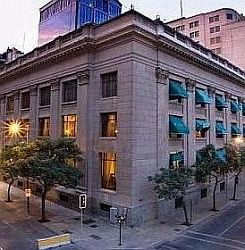 |
|
| Banco Central de Chile HQ |

Banco Central de Chile (BCCH) is the central bank of Chile established on August 22, 1925. The initiative arose as one of four projects presented by the Kemmerer mission. Since 1989, Banco Central de Chile is an autonomous entity. The institution began activities with a nominal capital of 150 million pesos, of which about 13% was contributed by the State, 40% by Chilean and foreign commercial banks operating in Chile and the remaining 47% by the public through a share subscription. In 1925, the peso became the monetary unit in Chile with a content of 0.183057 grams of pure gold. BCCH's roles and responsibilities include issuing banknotes and coins, regulating the amount of money in circulation and regulating the financial system and capital market. Banco Central de Chile is responsible for publishing national macroeconomic statistics, including monetary statistics, exchange rates, and balance of payment and national account indicators. The Bank’s headquarters was designed by the architect Alberto Cruz Montt. There are many valuable paintings by Chilean artists, which are distributed in the different halls and offices. BCCH also has a collection of Chilean bank notes and coins. The Bank's assets are mainly composed of financial instruments from international reserves.
Reserves: US$38.313 billion (June 2017)
Interest rate: 2.75% (June 2017)
President: Mario Marcel Cullell
Head office address:
Agustinas 1180
Santiago, Chile
Phone number: +56 2 670 2000
Website: http://www.bcentral.cl
